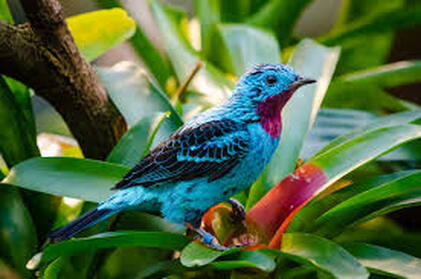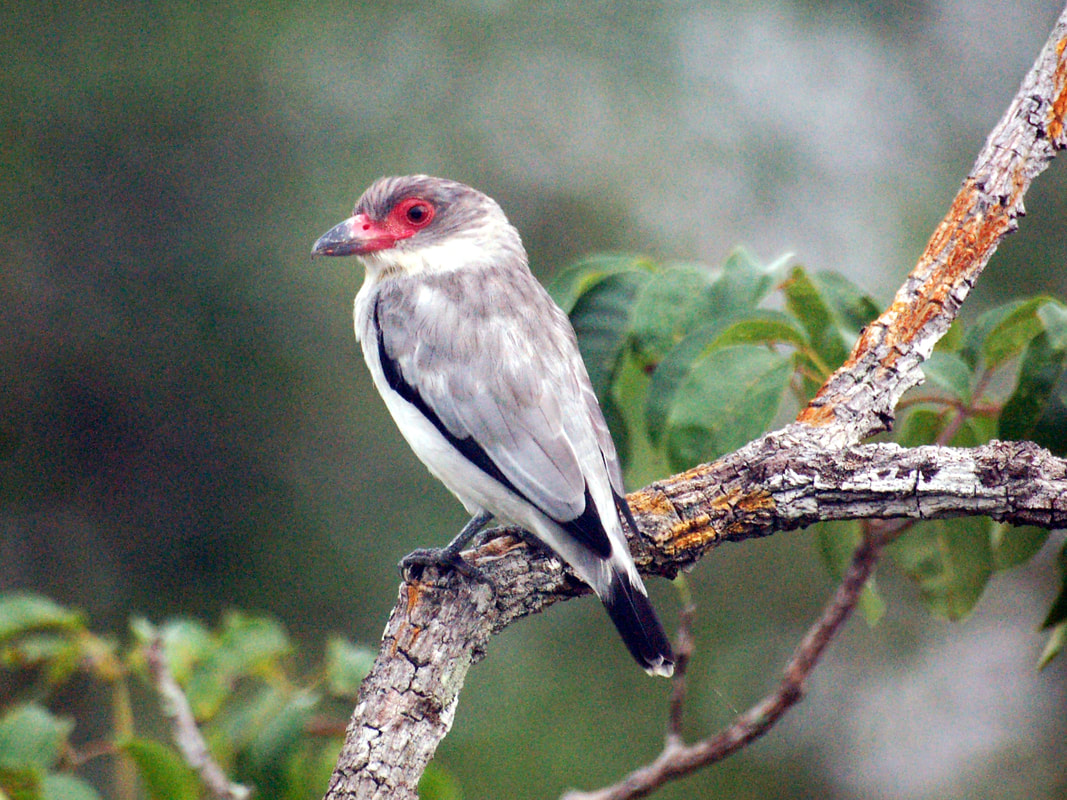Manakins & Becards - in Belize
White-Collard Manakin
White Collared Manakin - Chunky little bird of humid forest edge and second-growth thickets (especially with Heliconia plants) in tropical lowlands. Away from display areas, usually found in ones and twos perched quietly or feeding at fruiting trees and bushes from understory to canopy. Display often draws attention: loud clicks, buzzes, and whistles given by males low in understory. Unmistakable male often detected by low wing rattle in flight. Female greenish with yellow belly and orange legs.
BELIZE HABITAT - Understory and mid-level strata within broadleaf forest and forest edge; second-growth scrub. Where can I find this bird in Belize? Common resident on mainland north to central Orange Walk and north Belize; uncommon and local to north Orange Walk and east Corozal. |
Red-Capped Manakin
Red Capped Manakin - Chunky little bird of middle levels and understory in humid tropical forest of lowlands. Away from display areas, usually found in ones and twos perched quietly or feeding at fruiting trees and bushes from understory to canopy. Often sits still for long periods and easily overlooked. Male unmistakable: flame-red head glows in shady forest. Female notably drab, dull greenish with dull pinkish bill, dark legs, best identified by shape and behavior.
BELIZE HABITAT - Mid-levels to canopy within broadleaf forest, sometimes at forest edge. Found in more mature forest than White-Collard. Where can I find this bird in Belize? Fairly common resident on mainland. |
Cinnamon Becard
Cinnamon Becard - Medium-sized, overall rusty-colored bird of evergreen forest edge and clearings in humid tropical lowlands. Usually seen as singles or pairs at middle to upper levels in rather open trees. Like other becards, tends to perch fairly upright, quietly craning its head forward to peer around. Male and female look alike. Smaller and slimmer than female Rose-throated Becard, with pale eyebrow and graduated tail feathers.
BELIZE HABITAT - Mid-levels to canopy within broadleaf forest and forest edge. Where can I find this bird in Belize? Uncommon to fairly common resident in interior north to north Cayo; also west Orange Walk and locally in east Orange Walk. |
White-Winged Becard
White Winged Becard - Becards are reminiscent of flycatchers; they are medium-sized and have a rather flat head. Geographically variable: males in the north and west are gray with a black cap and back; in the Amazon primarily black overall, and both forms have bold black-and-white markings on wings. Female is nondescript with a rather plain face and pale yellowish underparts. Look for her buffy wingbars and buffy tips on the tail. Both sexes are similar to Black-and-white Becard; look for male’s black back and female's plain head (lacking rufous cap and black eyeline). Singles or pairs are found in wooded areas but not usually inside mature forest; they prefer edges and second growth. Usually found at middle levels in trees.
BELIZE HABITAT - Mid-levels at broadleaf forest edge, in second growth, and in open areas with scattered trees. Where can I find this bird in Belize? Uncommon to fairly common resident north recently to central Orange Walk and north Belize. Since first recorded in 1970 in Toledo, has spread steadily north, most likely in response to deforestation. |
Gray-Collard Becard
Gray Collared Becard - Scarce bird of tropical forest and woodland, from lowlands to highlands. Usually seen as singles or pairs at middle to upper levels, especially at fruiting trees; often travels with mixed-species feeding flocks of tanagers, orioles, warblers, etc. Tends to perch rather upright and quietly, easily overlooked. Male striking: gray, black, and white; no similar species in Mexico. Female is smaller than female Rose-throated Becard, with short pale eyebrow, contrasting wing and tail patterns (note graduated tail feathers). West Mexican female has rusty cap; elsewhere cap is blackish.
BELIZE HABITAT - Mid-levels within broadleaf and pine forest and forest edge. Where can I find this bird in Belize? Regular to locally uncommon resident on mainland, perhaps throughout. |
Rose-Throated Becard
Rose Throated Becard - Rather chunky, big-headed bird with a bushy crest. Widespread in tropical and subtropical areas, also locally in the highlands. Favors woodland and forest edge, but also found in brushy fields, hedgerows, and most habitats with a scattering of larger trees; often at fruiting trees. Feeds rather sluggishly, often craning its head and back and forth deliberately. Male varies from pale gray (in drier areas) to dark slaty gray (in rainforest); pink throat patch absent in darkest rainforest birds. Female also variable, but always has bushy blackish cap. Young male looks like female with variable pink on throat.
BELIZE HABITAT - Mid-levels to sub-canopy within deciduous to evergreen broadleaf forest and forest edge; second growth scrub. Where can I find this bird in Belize? Resident on mainland; common in Corozal, progressively less common southward; recorded on Ambergris Caye, where possibly a regular resident or a stray. |
Lovely Cotinga
Lovely Cotinga - Unobtrusive, rather chunky bird of forest canopy in tropical forest of humid lowlands. Most often seen as a single male perched on exposed high branches, less often at fruiting trees where can be quite low. Male is unmistakable: brilliant electric blue (glowing even at long range) with plum-colored throat and belly patch. Female very different: pale grayish overall with white scalloping above and dusky dappling below. Basically silent.
BELIZE HABITAT - Mid to upper strata within broadleaf forest interior; early in the morning often perches on exposed branches protruding above canopy. Where can I find this bird in Belize? Very uncommon to regular resident in interior north to central Cayo and (discontinuously?) in west Orange Walk; once at Lamanai east Orange Walk. |
Black-Crowned Tityra
Black Crowned Tityra - Handsome, mostly silvery gray bird of tropical lowland forest and adjacent semi-open areas with taller trees. Usually found at mid-upper levels of fruiting trees, sometimes in small groups that mix readily with the commoner Masked Tityra. Black-crowned is told from slightly larger Masked by its solidly black bill. Male is more silvery overall, with a black cap; female had brown face and smaller black cap. Tityras nest in tree cavities, that they sometimes steal from woodpeckers.
BELIZE HABITAT - Open to closed broadleaf forest interior and edge; open areas with scattered trees; pines. Where can I find this bird in Belize? Uncommon to locally fairly common resident on mainland. Often seen with Masked, although invariably less common. |
Masked Tityra
Masked Tityra - Handsome, mostly silvery gray bird of tropical and subtropical forest and adjacent semi-open areas with taller trees. Usually found at mid-upper levels of fruiting trees, sometimes in small groups. Identified readily by pinkish base to bill and pinkish ‘mask’ around eyes. Females in most areas have a dark brownish head, but in West Mexico the females have a pale gray head and back. Distinctive call is a wet quacking or farting sound.
BELIZE HABITAT - Open to closed broadleaf forest interior and edge; open areas with scattered trees; pines. Where can I find this bird in Belize? Common resident on main;and; uncommon resident on north Ambergris Caye. |










